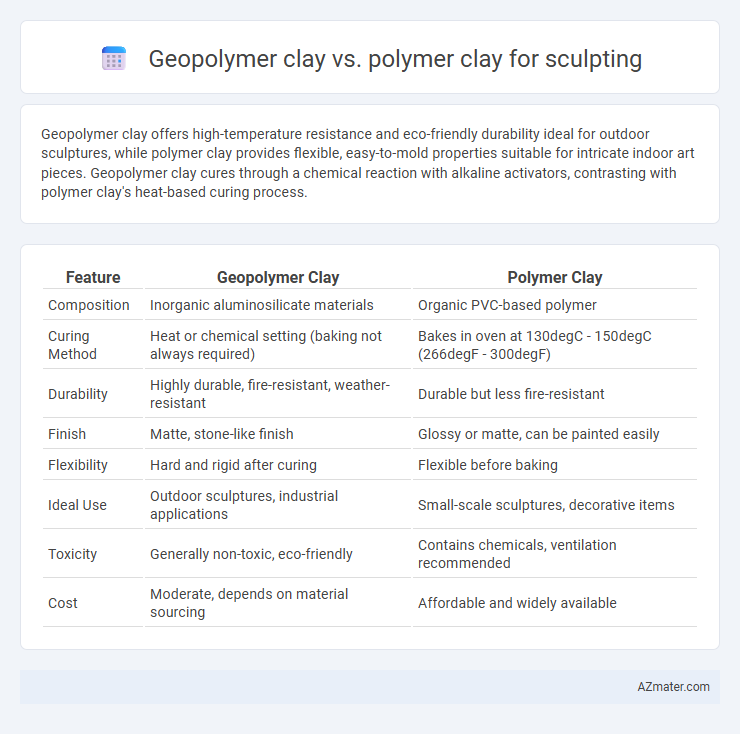Geopolymer clay offers high-temperature resistance and eco-friendly durability ideal for outdoor sculptures, while polymer clay provides flexible, easy-to-mold properties suitable for intricate indoor art pieces. Geopolymer clay cures through a chemical reaction with alkaline activators, contrasting with polymer clay's heat-based curing process.
Table of Comparison
| Feature | Geopolymer Clay | Polymer Clay |
|---|---|---|
| Composition | Inorganic aluminosilicate materials | Organic PVC-based polymer |
| Curing Method | Heat or chemical setting (baking not always required) | Bakes in oven at 130degC - 150degC (266degF - 300degF) |
| Durability | Highly durable, fire-resistant, weather-resistant | Durable but less fire-resistant |
| Finish | Matte, stone-like finish | Glossy or matte, can be painted easily |
| Flexibility | Hard and rigid after curing | Flexible before baking |
| Ideal Use | Outdoor sculptures, industrial applications | Small-scale sculptures, decorative items |
| Toxicity | Generally non-toxic, eco-friendly | Contains chemicals, ventilation recommended |
| Cost | Moderate, depends on material sourcing | Affordable and widely available |
Introduction to Geopolymer Clay and Polymer Clay
Geopolymer clay is an eco-friendly, inorganic material derived from aluminosilicate-rich sources, offering high heat resistance and durability, making it suitable for detailed sculpting and functional ceramics. Polymer clay is a synthetic, plastic-based medium composed of polyvinyl chloride (PVC) and plasticizers, known for its flexibility, vibrant colors, and ease of curing at low temperatures. Both materials cater to different artistic needs, with geopolymer clay favored for structural strength and polymer clay preferred for intricate, colorful designs.
Composition and Material Differences
Geopolymer clay is composed of aluminosilicate materials derived from natural minerals combined with alkaline activators, creating a heat-resistant and eco-friendly alternative ideal for structural sculptures. Polymer clay consists of a plasticized polyvinyl chloride (PVC) base mixed with plasticizers, pigments, and fillers, making it highly flexible and suitable for detailed, small-scale artwork with low heat resistance. The fundamental material difference lies in geopolymer clay's inorganic, chemically bonded structure versus the organic, synthetic polymer matrix of polymer clay, influencing durability, finish, and firing requirements.
Sculpting Techniques: Geopolymer vs Polymer Clay
Geopolymer clay offers superior sculpting techniques due to its malleable, stone-like texture that allows detailed carving and smoothing before hardening, making it ideal for intricate models and durable finished pieces. Polymer clay remains pliable until baked, enabling extended working time and fine detail manipulation using tools, but requires precise temperature control for curing. The choice impacts techniques: geopolymer suits structural sculpting with rigid, long-lasting results while polymer clay excels in flexible, colorful, and delicate designs requiring gradual shaping.
Workability and Texture Comparison
Geopolymer clay offers a gritty, stone-like texture with excellent workability for detailed sculpting and quick curing at room temperature, making it ideal for durable, weather-resistant pieces. Polymer clay features a smoother, more pliable texture that remains soft for extended periods, allowing intricate shaping and blending before baking in a home oven at around 265degF (130degC). While geopolymer clay excels in structural strength and natural finishes, polymer clay provides superior flexibility and color versatility for fine, delicate designs.
Curing and Firing Methods
Geopolymer clay cures through a chemical reaction at room temperature, requiring no kiln firing, making it ideal for sculptors seeking energy-efficient methods and heat resistance. Polymer clay needs to be baked in an oven at temperatures between 230degF and 275degF (110degC to 135degC) to harden, which can limit the size of sculptures due to oven constraints. The curing process of geopolymer clay results in a highly durable, fireproof finish, whereas polymer clay offers vibrant colors but less heat tolerance after baking.
Durability and Strength Assessment
Geopolymer clay offers superior durability and strength compared to polymer clay, making it ideal for long-lasting sculptures exposed to environmental stress. Its inorganic composition provides higher resistance to cracking, heat, and UV damage, whereas polymer clay tends to be more flexible but less robust over time. Geopolymer clay's enhanced structural integrity supports larger, more intricate designs that require enduring stability.
Environmental Impact and Sustainability
Geopolymer clay, derived from natural minerals such as metakaolin and industrial byproducts like fly ash, offers a more sustainable option compared to polymer clay, which is petrochemical-based and contributes to plastic pollution. Geopolymers produce fewer greenhouse gas emissions during manufacturing and are often non-toxic and recyclable, making them environmentally friendlier for sculpting. Polymer clay, while versatile and durable, relies on PVC and plasticizers that pose long-term ecological risks and are harder to biodegrade, resulting in greater environmental impact.
Cost and Accessibility
Geopolymer clay offers a cost-effective alternative to polymer clay, with prices typically lower due to its use of readily available raw materials like fly ash and metakaolin. Polymer clay, while widely accessible in art and craft stores globally, tends to be more expensive because of its synthetic components and brand value. Both clays are user-friendly, but geopolymer clay's affordability and raw material sourcing make it particularly attractive for large-scale or budget-conscious sculpting projects.
Best Uses and Artistic Applications
Geopolymer clay excels in creating durable, heat-resistant sculptures ideal for functional art pieces like pottery and architectural models, thanks to its inorganic composition and chemical curing process. Polymer clay offers exceptional flexibility and vibrant color options, making it perfect for detailed miniatures, jewelry, and mixed media projects due to its easy sculptability and oven-bake curing method. Artists choose geopolymer clay for long-lasting outdoor installations, while polymer clay is preferred for intricate, colorful designs demanding fine detail and smooth finishes.
Choosing the Right Clay for Your Sculpting Project
Geopolymer clay offers superior heat resistance and structural strength, making it ideal for outdoor sculptures or projects requiring durability. Polymer clay excels in flexibility and ease of use, perfect for detailed, small-scale works and can be baked in standard ovens at low temperatures. Selecting the right clay depends on the project's environment, desired finish, and curing method, ensuring the sculpture's longevity and aesthetic integrity.

Infographic: Geopolymer clay vs Polymer clay for Sculpting
 azmater.com
azmater.com